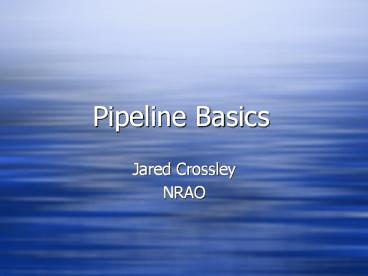Pipeline Basics - PowerPoint PPT Presentation
Title:
Pipeline Basics
Description:
And Imaging. of VLA continuum data. May also process spectral line data. ... Diagnostic plots. Imaging ... VLA Pipeline System: (Imaging the VLA Archive) ... – PowerPoint PPT presentation
Number of Views:104
Avg rating:3.0/5.0
Title: Pipeline Basics
1
Pipeline Basics
- Jared Crossley
- NRAO
2
What is a data pipeline?
- One or more programs that perform a task with
reduced user interaction. - May be developed as an extension of a more
general and more interactive software system.
3
Why use it?
- Saves time
- Especially with large (repetitive) data sets
- Interactive data reduction may take a lot of time
(even for an expert) - Consistency
- Increased accessibility of a data reduction
system - You dont have to be an expert to use a
pipeline. - A good learning tool -- with good documentation
4
Building a Pipeline Start simple
- Build a pipeline in layers.
- The lowest level of the pipeline should still be
interactive. - For example
- Level 1 allow the user the specify input
parameters needed by the following tasks. - Level 2 find the best default parameter values
for most data sets. - Given these default values, most data can be
processed with little interaction. - Focus on a subset of input data.
5
Building a Pipeline continued
- The pipeline will evolve with time
- Parameter dependencies will reveal themselves
- Data processing algorithms will become apparent
to the user. When well defined, add it to the
pipeline. - Acquire metadata when possible. This can be used
to initialize parameters.
6
Areas of concern
- How much control should the user be given?
- Depends on the target audience. Experts want
more control than novices. - A compromise is lots of controls, but most of
them pre-set to good initial conditions.
7
Areas of concern
- How many output diagnostics should the pipeline
produce? - Varies by processing goal and user preference.
- If possible, include a pipeline parameter
determines the amount of diagnostics.
8
More on Output
- In addition to the primary output product,
consider outputting calibrated data and log
files. - This allows advanced users to build upon what the
pipeline has done - And, this allows for quick upgrades to data
products.
9
Validating Output
- This is job is necessarily interactive.
- However, a pipeline can simplify the process by
- Providing an easy way to view output, including
diagnostics - And an easy way to delete (or flag) unacceptable
output.
10
The VLA (AIPS) Pipeline
11
Description
- The pipeline is a script (AIPS run file) that
automates - Editing,
- Calibration,
- And Imaging
- of VLA continuum data. May also process
spectral line data. - Emulates an AIPS task
- Takes input parameters
- Outputs images and calibration plots
- Suggested default parameters contained in AIPS
memo.
12
Demo VLA (AIPS) Pipeline
- To use the AIPS pipeline load data into AIPS
split out different frequencies.
13
Demo VLA (AIPS) Pipeline
- Set the VLARUN input parameters.
Flagging control
Pause during calibration
Diagnostic plots
Imaging control
Self-cal (fragile)
14
Demo VLA (AIPS) Pipeline
- Image output by pipeline (axes and wedge added)
15
Demo of VLA Pipeline System (Imaging the VLA
Archive)
16
Description
- The VLA Pipeline System is an extension of the
AIPS pipeline. - Includes
- Data acquisition, and preparation for processing
- Data processing (AIPS pipeline)
- Image finalization, and export
- Archiving
- Easy interactive data validation
17
Demo VLA Pipeline
- At a high level of pipeline automation, initial
user interaction takes place only on the command
line. - The user can query the raw data archive via a
Perl script
18
Demo VLA Pipeline
- Next, select data files for download and filling.
Select files
Download
19
Demo VLA Pipeline
- A Unix shell script waits to be called by cron.
Start AIPS
Execute AIPS Pipeline
20
Demo VLA Pipeline
- After processing, the output is archived via
scripts invoked by cron. - The data is now available online.
- The final step is image validation
21
Demo VLA Pipeline
- A web-based validation tool allows for validation.
22
Demo VLA Pipeline
- Images and diagnostics can be viewed together and
flagged for removal.
23
For more info
- About AIPS Pipeline (VLARUN)
- AIPS Memo 112, by L. Sjouwerman.
http//www.aips.nrao.edu/aipsmemo.html - VLARUN online documentation. From the AIPS
prompt type explain VLARUN - About Pipeline System and NVAS
- See the NVAS web page. http//www.aoc.nrao.edu/vl
bacald - For data acquisition scripts, see J. Crossleys
web page. http//www.aoc.nrao.edu/jcrossle/ - About pipeline basics
- See notes on J. Crossleys web page.















![Pipeline Insights: Surgical Wound Infections[2015] PowerPoint PPT Presentation](https://s3.amazonaws.com/images.powershow.com/8305949.th0.jpg?_=201511250610)















